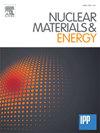Oxidation behaviour of CVD and electroplated Al-base coatings for EUROFER97
IF 2.7
2区 物理与天体物理
Q1 NUCLEAR SCIENCE & TECHNOLOGY
引用次数: 0
Abstract
The reduced activation ferritic/martensitic (RAF/M) EUROFER97 is the primary candidate for coolant-facing alloys of the European DEMO reactor. However, EUROFER97 will face harsh environment, and it might experience enhanced degradation due to the synergistic exposure to flowing high temperature water coolant, tritium embrittlement and ionising radiation. A possible solution is to use self-passivating coatings that can interact with the environment to provide corrosion and tritium permeation protection during in service operation. In this study, EUROFER97 was firstly Al-base coated using either a chemical vapour deposition (CVD at 700 °C or 750 °C) or electroplating process (room temperature); and then oxidised in a 2-step process using the same tempering (980 °C) and normalisation (760 °C) temperatures used for EUROFER97. These temperatures were used to assess their suitability for obtaining a stable and protective Al-base oxide without altering the microstructure of EUROFER97. Advanced microscopy characterizations revealed the formation of a ≈0.6 µm α-Al2O3 layer over an intermetallic Al-Fe-rich interdiffusion microstructure of ≈80 µm depth. However, the interdiffusion layer was highly decorated with voids that might act as stress concentrators during in-plant service, thus being detrimental to the material performance. This study compares different Al-base coating techniques and provides a preliminary insight on the selection of oxidation temperatures for EUROFER97, finding that the current 2-step oxidation process needs further optimisation before being industrialised.

CVD和电镀铝基EUROFER97涂层的氧化行为
低活化铁素体/马氏体(RAF/M) EUROFER97是欧洲DEMO反应堆冷却面合金的主要候选材料。然而,EUROFER97将面临恶劣的环境,并且由于流动的高温水冷却剂、氚脆化和电离辐射的协同作用,它可能会经历更强的降解。一种可能的解决方案是使用可与环境相互作用的自钝化涂层,在服务操作期间提供腐蚀和氚渗透保护。在这项研究中,EUROFER97首先采用化学气相沉积(CVD在700°C或750°C)或电镀工艺(室温)进行铝基涂层;然后使用与EUROFER97相同的回火(980°C)和正火(760°C)温度进行两步氧化。这些温度被用来评估它们在不改变EUROFER97微观结构的情况下获得稳定和保护性铝基氧化物的适用性。先进的显微镜表征显示,在深度约80 μ m的富al - fe金属间互扩散微观结构上形成了≈0.6 μ m的α-Al2O3层。然而,扩散层上布满了空隙,这些空隙可能会在装置内使用时起到应力集中的作用,从而对材料的性能不利。本研究比较了不同的铝基涂层技术,并对EUROFER97氧化温度的选择提供了初步的见解,发现目前的两步氧化工艺在工业化之前需要进一步优化。
本文章由计算机程序翻译,如有差异,请以英文原文为准。
求助全文
约1分钟内获得全文
求助全文
来源期刊

Nuclear Materials and Energy
Materials Science-Materials Science (miscellaneous)
CiteScore
3.70
自引率
15.40%
发文量
175
审稿时长
20 weeks
期刊介绍:
The open-access journal Nuclear Materials and Energy is devoted to the growing field of research for material application in the production of nuclear energy. Nuclear Materials and Energy publishes original research articles of up to 6 pages in length.
 求助内容:
求助内容: 应助结果提醒方式:
应助结果提醒方式:


